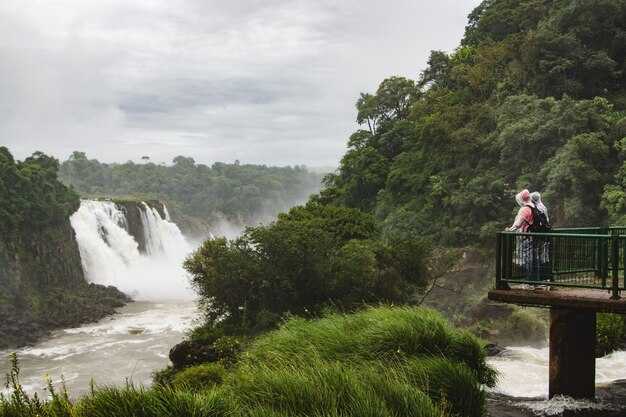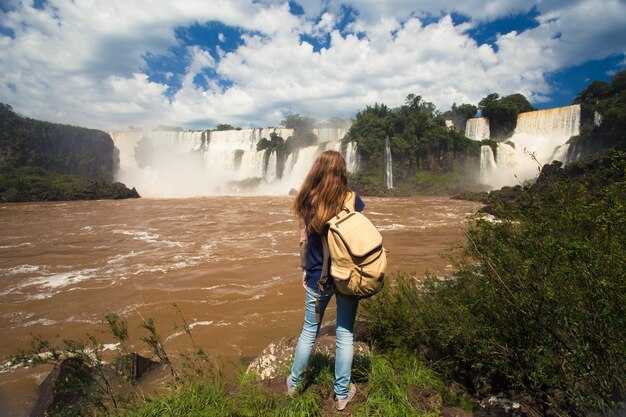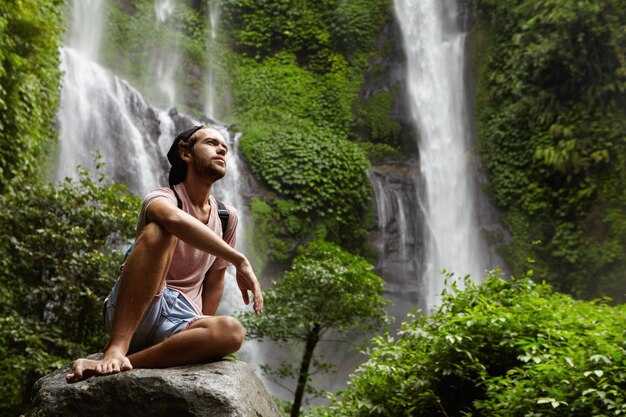advice: arrive before 9 am to enjoy cooler temperatures and clearer viewpoints on the Brazilian side. If you have arrived, head straight to the upper decks to catch the spray without long lines. Plan your route to maximize short walks between shaded spots and bring a light backpack with sunscreen and a microfiber towel.
Find your base: The belmond Hotel das Cataratas on the Brazilian side offers easy access to the park entry. If you lean toward budget options, frequent hostels around Foz do Iguaçu keep daily costs reasonable. michaela, an australian traveler, says a flexible plan and conversation with staff unlock quiet paths after rain. bring an amount for local taxis or shuttle buses, and reserve a couple of hours for a relaxed morning walk.
What to wear and pack: Wear sturdy shoes with grip for slippery stones. dont forget a lightweight rain jacket; the spray from the falls sticks to everything. Pack a compact poncho, bottled water, and a small power bank for photos. A daily plan helps you hit viewpoints in the best light, especially as temperatures rise.
Plan your route: Start at the main Brazilian circuit and work your way to the Garganta do Diabo overlook. Use the park shuttle to hop between trailheads, especially in peak heat. Look for wildlife, like toucans and coatis, along shaded stretches. A well-timed visit in the morning or late afternoon yields better lighting for photos.
Practical tips: Bring protection for cameras; the spray can fog lenses. dont rely on data connectivity in the park; download offline maps beforehand. The amount of walking is moderate but stairs add up; take breaks and hydrate. Consider a late-afternoon viewpoint, when temperatures drop again and mist creates rainbows.
Best Time to Visit the Brazilian Side for Garganta do Diabo Viewpoints
Plan your visit for May or September and start before 9 a.m. to catch Garganta do Diabo viewpoints on the Brazilian side with soft light and thinner crowds.
In these dry-season months, the wide catwalk stays dry, the air is comfortable, and visibility is best for photography. If you come in summer, be ready for higher humidity and occasional showers that heighten the mist and create dramatic portraits; the views remain powerful, especially in early morning light or late afternoon when the land and forest contrast most.
weve found that morning visits pay off: over the years, travelers have learned to optimize timing by starting early; weekdays are generally calmer; backpackers and local guests mix with day-trippers on weekends, but the quieter hours are still present. To simplify logistics, use rideshare from town to the park entrance, a reliable means to avoid parking hassles. On-site facilities provide a simple lunch option at the gate, but for a fuller meal you can purchase in town or at a nearby mall after your visit. wifi coverage is strongest near the main plaza; along the main catwalks it can be spotty, so download offline maps in advance. At the gate you obtain a map and can purchase tickets online to start smoothly. The Garganta route on the Brazilian side is wide and well-maintained, with viewpoints that place you between the spray and the forest land; some overlook on the opposite bank offer a different perspective if you plan a separate day trip to the Argentine side.
Timing and viewpoints
- Start early: aim for 7:00–9:00 a.m. to beat crowds and catch the best light.
- Prefer May or September for lower rainfall and comfortable temperatures, with strong water flow still present.
- Choose weekdays when possible; weekends draw backpackers and families, increasing crowding at key lookouts.
- Check the weather and park alerts the night before; morning mists can affect visibility if you start too late.
Practical planning

- Wear sturdy shoes for a wide, well-maintained path that remains mostly flat but can be slick after rain; plan for tiny spray droplets on skin and glasses.
- Pack light rain gear, sunscreen, and a small backpack; dorm-style hostels around town offer budget options if you’re traveling with a group.
- Purchase tickets online in advance to start your day smoothly; at the gate you can obtain a map and you’ll see coverage updates on-site.
- Use rideshare means to reach the entrance; it’s a common, cost-effective option for solo travelers and groups.
- Be mindful of wifi coverage: stay offline with maps if the signal is weak on the trails; download the route beforehand.
- Consider adding a second day to explore the Argentine side for a fuller variety of viewpoints between the two countries.
Getting There: From Foz do Iguaçu to the Brazilian Park Entrance
Book a private transfer or use a reliable taxi to reach the Brazilian Park Entrance quickly. From Foz do Iguaçu to the entrance, expect about 25–30 km of road, 30–45 minutes in light traffic; peak times can stretch it to 60 minutes. If you arrive via the IGU airport or other area airports, a pre-booked shuttle or taxi offers door-to-gate service, saving you stops and backtracking. Here’s a practical approach that keeps everyone on track.
Two solid ride options: private transfer or public bus
Option A: Private transfer. A driver waits in the arrivals hall at IGU or at your hotel and delivers you directly to the Park Entrance. Expect to pay around R$80–120 one way, depending on your hotel location and traffic; it’s better to pay a bit more for reliability, especially with kids or a lot of gear. If you’re traveling with others, the per-person cost drops and the space helps you pack everything you need. Passengers appreciate the convenience after travel, and the driver can stop for a quick photo along the road if you ask.
Option B: City bus. From downtown Foz, Bus 120 Cataratas runs roughly every 30–40 minutes and stops at the park gate. The ride takes about 60–75 minutes and costs around R$5–7. Board at the Terminal de Ônibus or at major urban stops; you’ll avoid parking hassles but share the ride with other passengers. If you missed the first bus, there are later departures–check the current timetable at your hotel or the terminal; plan to arrive early to beat the heat and crowds. Instead, if you’re on a tight budget, this is a better choice for the day.
There, crossing to the argentinean side is optional but can be a good complement in a full day. If you decide to cross, bring your passport and be prepared for customs checks; plan a separate entry and exit window, and note that afternoon temperatures can rise a few Fahrenheit degrees. If you want to explore ciudad neighborhoods on the other side, do it after you finish here and return for the Brazilian gates.
Practical packing and planning: pack light, leave bulky bags at the hotel if possible, and carry a small water bottle; the weather on the Brazilian side is sunny most days. In summer, temperatures often peak in the 80s or 90s Fahrenheit, so sunscreen, a hat, and a light jacket for cooler mornings help. The entry plaza is a short walk from the bus stop, but you’ll do more walking inside the park beyond the gate. Here, the shortest walk from the gate to the main outlooks takes about 15–25 minutes. If you’re touring with kids, pace yourself and add rests; everyone benefits from a relaxed rhythm. Create a simple itinerary list to guide your day, then review it at the bus stop to learn about current conditions and time windows, and leave some buffer for unexpected stops with others who share tips and plans.
Finally, a quick note to add to your plan: begin at the entrance, buy tickets, and consider the electric train for faster access to the most famous viewpoints on the Brazilian side. The vistas are amazing, and mornings offer softer light for photos. If you want a special day that blends park scenery with city culture, this route is worth the effort. The plan is straightforward, practical, and designed for smooth travel; by following these steps, you’ll avoid delays and enjoy the falls with less stress.
Ticketing, Parking, and Entrance Logistics for Garganta do Diabo
Purchase tickets online in advance and select an earlier time slot to make the visit easier and to avoid crowded queues during peak months.
Ticketing options on the official site include single-entry passes and combination experiences. Price varies by age and country of residence, with exchange rates available at checkout. The site accepts cards and cash, and the counter at the entrance can process exchanges for nearby networks if necessary.
Parking near the entrance is limited. Lot A sits closest to the Brazil-side entry, while Lot B is about a kilometre away along a walkable path. Expect hourly rates, with payment possible at the booth or via a mobile app. Plan for 1–2 hours if you want to explore both circuits and the lookout points without rushing.
Entrance logistics place you at a controlled gateway for Garganta do Diabo. Gates open early and close in the late afternoon; bring only essential belongings to speed checks, as staff conduct standard security inspections. Have your requirements ready–photo IDs, tickets, and any permitted tech–while keeping belongings compact to avoid intrusive lines. Use the main walkway and circuit route to reach the famous lookout without backtracking.
Local guidance from avid visitors adds value: Silva, a guide from Barroso, suggests starting at the lower circuit lookout to catch the best light, then following the walkways along the main circuit. The route is walkable for most guests, with a comfortable kilometre-scale stretch between lookouts. After the falls, many travelers enjoy a relaxed dinner nearby before departing for the airports or hotels in the country.
| Kategorie | Empfehlung | Anmerkungen |
| Ticketing | Book online; choose morning slot; print or save on phone | Price varies by country and age; exchange available at counter |
| Parken | Use Lot A near entry; Lot B is a short kilometre walk | Pay hourly; app or gate; plan 1–2 hours |
| Entrance | Arrive early; carry only essentials | Security checks are standard; lookouts along the walkway |
| Tipps | Bring water, wear walkable shoes, consider a dinner stop after | Avid photographers will appreciate early light; Silva recommends route via lower circuit |
The Main Trail: Distances, Prime Viewpoints, and Walking Time to Devil’s Throat
Start at the entrance and walk directly toward Garganta do Diabo; this one-way segment conveniently sets you up for the final platform and definitely feels efficient for most visitors.
Der Hauptweg zur Teufelsschlucht erstreckt sich über etwa 2 km in eine Richtung, wobei ein angenehmes Wandertempo im Freien etwa 40–50 Minuten Gehzeit ergibt. Wenn Sie planen, an jedem Aussichtspunkt zu verweilen und viele Fotos zu machen, sollten Sie 60–90 Minuten für den gesamten Weg bis zur finalen Plattform einplanen.
Hauptgesichtspunkte und die Laufweite
Nach etwa 0,7–0,9 km bietet der erste Aussichtspunkt einen weiten Blick auf die unteren Kaskaden und den Sprühnebel, der bei hellem Licht Regenbögen erzeugt. Wenn man weitere 0,5–0,6 km geht, erreicht man eine Plattform auf halbem Weg mit einem breiteren Panorama über den Fluss und die bewaldeten Ufer.
Die letzte Plattform der Garganta do Diabo erreicht man nach etwa 2 km und bietet die höchste und aufregendste Nahaufnahme der hufeisenförmigen Kaskade. Dies ist der hohe, dramatische Moment, den jeder fotografiert, mit Gischt in der Luft und einer dramatischen Größe, die den Rest des Weges lohnenswert erscheinen lässt.
Entlang der Strecke finden Sie Sitzgelegenheiten und schattige Plätze zum Ausruhen, was den Spaziergang für Familien und alle, die auf Hitze oder Sonne achten, angenehmer macht. Für Mobilitätsbedürfnisse erkundigen Sie sich im Besucherzentrum nach einem Aufzug, der den Zugang zu den oberen Terrassen erleichtert; einige Abschnitte bieten Rampenzugang oder alternative Routen zum Hauptdeck.
Ob Sie am Morgen oder am Nachmittag kommen, Schatten und Sitzgelegenheiten helfen Ihnen, ein gleichmäßiges Tempo zu halten. Von den Aussichtspunkten aus sehen Sie den Fluss, der sich weit nach Nordwesten ausdehnt, und den umliegenden Dschungel, wobei in ruhigeren Stunden Tierbeobachtungen möglich sind. Achten Sie auf Schilder auf Spanisch und Portugiesisch, die Entfernungen angeben, und halten Sie die Karten für eine detaillierte Planung Ihrer spezifischen Stopps bereit. Wenn Sie sich energiegeladen fühlen, wird jeder Aussichtspunkt zu einer Outdoor-Aktivität, die den Weg selbst in einen kompakten Ausflug verwandelt.
Dieser Plan kann von Ihnen an Ihr eigenes Tempo und Ihre Interessen angepasst werden. Wenn Sie sich in der Gegend aufhalten, bieten Ihnen nahegelegene Restaurants schnelle Gerichte vor oder nach dem Spaziergang; wenn Sie unter Zeitdruck stehen, können Sie die Route verkürzen, indem Sie nach dem ersten oder zweiten Aussichtspunkt umkehren und trotzdem die wesentlichen Highlights einfangen.
Was man für Regenwaldspaziergänge anzieht und einpackt
Beginnen Sie mit schnell trocknenden Hosen oder Shorts und einer atmungsaktiven, wasserdichten Jacke; tragen Sie robuste, geschlossene Schuhe mit gutem Halt. Wenn Sie einen Fahrradtransfer oder eine kurze Fahrt zwischen den Spots planen, wählen Sie Schuhe mit sicherem Sitz und bringen Sie Handschuhe mit.
Schichten helfen: eine feuchtigkeitsableitende Basisschicht, eine leichte Zwischenschicht und eine kompakte Regenjacke. Was Sie tragen, hängt von der Vorhersage und Ihrer Toleranz gegenüber Feuchtigkeit ab; morgens ist es kühler und in höheren Lagen kann es schnell ansteigen. Regen kann schnell kommen, also seien Sie vorbereitet.
Was zu packen ist
Tragen Sie vom Eingang aus einen 8-12 Liter Tagesrucksack mit einem Drybag für Elektronik. Packen Sie eine Trinkflasche oder ein Trinksystem ein; planen Sie mindestens 1,5 Liter für einen 60-90-minütigen Spaziergang ein.
Sonnenschutz: Hut, Sonnenbrille, Sonnencreme. Insektenschutz: Repellent. Regenschutz: Poncho oder leichte Regenjacke, falls Ihrem Rucksack eine Hülle fehlt.
Wasserdichtes Gehäuse für ein Telefon oder eine Kamera; Ersatzbatterien; ein Müsliriegel für Energie.
Thermen sind in der Nähe, bringen Sie also ein Handtuch mit, falls geplant ist, nach dem Spaziergang die Thermen zu besuchen.
Führen Sie Bargeld in Peso für Grenzpunkte mit sich; die meisten Einkäufe innerhalb des Parks akzeptieren Karten, aber einige Stände sind auf Bargeld angewiesen. Für Unterkunft und Verpflegung gibt es Hotels und Restaurants in der Nähe; planen Sie entsprechend.
Nationale und internationale Besucher können Transfers und Taxis vor dem Eingang arrangieren; die Öffnungszeiten variieren je nach Saison. Die meisten Rundgänge dauern 60-90 Minuten; es gibt stark frequentierte Tage, planen Sie also zusätzliche Minuten für Fotospots und Aussichtspunkte ein.
Fotografie-Tipps: Die Iguazu-Wasserfälle von der brasilianischen Seite aus aufnehmen
Begib dich bei Tagesanbruch in die Gegend von Porto, um scharfen Sprühnebel und warmes Licht auf der Salto-Plattform zu erleben; halte ein lichtstarkes Objektiv bereit und wische die Feuchtigkeit häufig von deinem Filter, um scharfe Kanten am Nebel zu erhalten. Entwickle Aufnahmegewohnheiten: Überprüfe das Licht alle paar Minuten und überblicke die Szene, bevor du dich festlegst, damit du keinen flüchtigen Regenbogen verpasst.
Auf der brasilianischen Seite sind die Wanderwege in ihren Blickwinkeln begrenzt. Planen Sie daher eine 60-90-minütige Tour ein, um die wichtigsten Aussichtspunkte und die inneren Baumkronenpfade abzudecken. Überprüfen Sie die aktualisierten Parköffnungszeiten und Abfahrtszeiten, um Ihren Zeitplan auf ruhigere Momente abzustimmen; Datum und Wetter beeinflussen die Reflexionen, und die Gesamtbedingungen können sich schnell ändern. Wenn Sie Misiones-Reisen kombinieren, koordinieren Sie sich sorgfältig, bleiben Sie aber flexibel, um aufdringliche Menschenmassen zu vermeiden. Nutzen Sie dies als Grundlage für die Planung Ihrer Route, um das Sonnenlicht auf jeder Aussicht optimal zu nutzen.
Im Park können Menschenmassen in der Nähe der Hauptplattformen aufdringlich sein. Versuchen Sie, direkt nach einer Sprühfontäne zu fotografieren und treten Sie dann an die üppigen Ränder, um intime Aufnahmen in Wassernähe zu machen. Achten Sie auf Wildtiere entlang der Ränder, einschließlich Katzen. Das Parken ist in der Nähe des Eingangs bequem, aber kehren Sie zurück, bevor der Shuttle-Verkehr seinen Höhepunkt erreicht. Sie werden einige überraschend ruhige Winkel entlang der Nebenwege gefunden haben, und Sie werden froh sein, bequemes Schuhwerk zum Schutz Ihrer Füße getragen zu haben.
Beste Zeiten und Aussichtspunkte
Das beste Licht gibt es nach der Morgendämmerung; vom Salto-Aussichtspunkt aus können Sie einen Regenbogen einfangen, während die Sonne aufsteigt. Von einigen Aussichtspunkten aus sehen Sie riesige Ausblicke auf den Wasservorhang und verschieben sich dann entlang des Boardwalks, um die Wasserfälle so einzurahmen, dass der Sprühnebel durch den Wald zieht. Für extrem dramatische Silhouetten verweilen Sie bis zum späten Vormittag und erneut am späten Nachmittag, wenn sich die Schatten entlang der Kaskade ziehen. Erwägen Sie eine zweite Runde auf der inneren Schleife, um Wasserbänder durch die Bäume einzufangen. Wählen Sie insgesamt ein paar wichtige Punkte aus und verwenden Sie ein leichtes Stativ, um ein Wackeln auf dem Boardwalk zu vermeiden, während Sie immer Platz lassen, um den sich ändernden Sprühnebel zu verfolgen.
Ausrüstung, Einstellungen und Planung

Verwende ein Weitwinkelobjektiv (16-35mm) für Panoramen und ein mittleres Teleobjektiv (70-200mm) für Nahaufnahmen der Wasserflächen und nebligen Auren. Stelle die Belichtung auf etwa f/8–f/11 und ISO 100–200 ein; für seidiges Wasser probiere 1–2 Sekunden mit einem stabilen Stativ oder wechsle zu schnelleren Verschlusszeiten, wenn der Wind die Gischt verweht. Ein Polarisationsfilter hilft, Blendungen an hellen Tagen zu reduzieren, und ein Neutraldichtefilter verlängert deine Langzeitbelichtungen. Fotografiere im RAW-Format und verwende Apps, um Wanderwege zu kartieren, Parkplätze zu überprüfen und Datums-/Zeitfenster und Abfahrten zu verfolgen. Wenn du in der Nähe übernachtest, passt ein 2–3-Stunden-Fenster für ein entspanntes Tempo; für familienfreundliche Ausflüge halte die Abschnitte kurz und erlaube eine Option für einen luxuriösen Aufenthalt in der Nähe. Wenn du Misiones-Reisen kombinierst, findest du mehr Landschaft und weniger Wartezeiten. Beende den Ausflug mit einem kurzen Füße-Check: Tritt zurück, um das Ausmaß einzuschätzen und deine Ausrüstung vor Spritzwasser zu schützen.



Kommentare